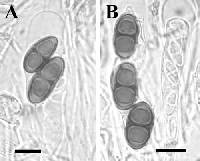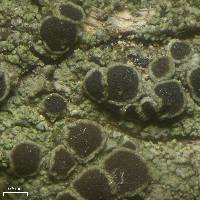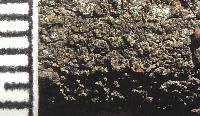
- Home
- Search
- Images
- Species Checklists
- US States: O-Z >
- US National Parks
- Central America
- South America
- US National Parks
- Southern Subpolar Region
|
|
|
|
Family: Physciaceae
|
MB#484378 Type. U.S.A. NEW MEXICO. San Miguel Co., 28 mi (54 km) SW of Las Vegas, 2.5 mi (4.8 km) W of Sands, on Juniperus, 6 500 ft (1 980 m), 11 June 1957, S. Shushan S11108 (COLO, holotype!). Description. Thallus usually thick, typically dark grey to grey‑green or brownish but sometimes lighter, comprised of minute verrucae, ca. 0.20 mm in diam., becoming continuous or areolate; areoles to 0.60-1.00 mm wide, often with upturned margins; surface plane or rugose, shining; margin indeterminate; prothallus lacking; vegetative propagules present; consoredia frequently developing along cracks and on upturned margins of areoles, 0.05-0.10 mm in diam.; sometimes breaking into soredia 25-35 µm in diam. Apothecia innate at first and often erumpent, remaining broadly attached, frequent, not usually contiguous, to 0.35-0.80 mm in diam.; disc black, plane, sometimes becoming fissured and/or markedly convex; thalline margin concolourous with thallus, or epinecral layer often broken at first, margin then lighter grey, 0.05-0.10 mm wide, entire, persistent or becoming excluded; excipular ring absent. Apothecial Anatomy. Thalline exciple 40-85 µm wide laterally; cortex 5-10 µm wide; crystals lacking in cortex and medulla; epinecral layer ca. 10 µm wide; cortical cells to 4.0-6.0 µm wide, pigmented or not; algal cells to 9.0-13.0 µm long; proper exciple hyaline, 5-10 µm wide laterally, to 10-25 µm wide at periphery; hypothecium hyaline, (25-)50-100 µm deep; hymenium 60-90 µm high, not inspersed; paraphyses 2.0-2.5 µm wide, conglutinate, with apices to 3.5-4.5(-6.0) µm, darkly pigmented, immersed in dispersed pigment forming a dark, red‑brown epihymenium; asci clavate, 45-65 x 14-19 µm. Ascospores 8/ascus, Type A development, Physcia‑type, (12.5-)16.0-17.0(-20.5) x (6.5-)8.0-8.5(-9.5) µm, average l/b ratio 1.9-2.2, lumina angular at first, becoming more rounded, retaining thickened apical wall until overmature, canal very broad; torus present at maturity; walls not ornamented. Pycnidia ca. 0.10 mm in diam., immersed in thallus, ostiole pigmented; conidiophores type I; conidia bacilliform, 3.0-5.0 x ca. 1.0 µm. Chemistry. Spot tests all negative; secondary metabolites not detected. Substrate and Ecology. As its name suggests, Rinodina juniperina is most common on juniper. It has been found on Abies concolor, Juniperus californica, J. deppeana, J. monosperma, J. osteosperma, J. scopulorum, Pinus edulis, P. ponderosa, Prunus virens, Pseudotsuga menziesii, Quercus emoryii and Q. gambelii, and on wood, particularly of Juniperus species. Collected at elevations of 1,020-2,800 m. It has been found growing with R. boulderensis and R. grandilocularis. Distribution. A North American endemic with a distribution centered on the Colorado Plateau, similar to R. grandilocularis but more widespread. It ranges from the Black Hills in the northeast to southern California and northern Baja California in the southwest. Note that the coastal record for California (Sheard and Mayrhofer 2002,) is erroneous. Notes. Rinodina juniperina is usually characterized by its thick thallus and shining surface due to the epinecral layer, and often by the presence of consoredia along the upturned areole margins and cracks in areole surfaces. The spores belong to the Physcia-type but the apical wall thickening becomes diminished and may ultimately disappear, therefore converging with the Physconia-type. The spore length is variable having a CV >10% and this variation is often evident within a single collection. Lignicolous specimens which are usually more exposed, are darker, often brownish, with better developed consoredia than those on more shaded, corticolous substrates. The erumpent apothecia, shining thallus and inflated spore lumina are reminiscent of R. grandilocularis. However, that species lacks consoredia and has significantly larger, Physconia-type spores with inflated lumina from a very early stage in spore development. Poorly developed specimens of R. juniperina could possibly be confused with R. archaea, another primarily lignicolous, western species, but that species has a matt thallus, always lacks vegetative propagules and possesses larger, Physconia-type spores. Specimens examined [not reported by Sheard & Mayrhofer (2002)]. U.S.A. ARIZONA. Cochise Co., Chiricahua Mountains, T.H. Nash 15780, 22619 (ASU); W.A. Weber 24703, 24732 (COLO); Chiricahua Nat. Mon., T.H. Nash 9755 (ASU); Portal, 1960, W.A. Weber (COLO); Coconino Co., Grand Canyon Nat. Park, T.H. Nash 31038; Hermit's Rest, M. Boykin 2730; South Rim Grand Canyon, T.H. Nash 4988; Sycamore Canyon, T.H. Nash 30037; Gila Co.,1 km S Payson, B. Kantrud 223 (all ASU); 1994, J.W. Sheard (SASK); 2 km S Payson, T.H. Nash 39388 (ASU); Graham Co., Stockton Pass Campground, C.M. Wetmore 14475 (MIN); Navajo Co., north rim Black Mesa, T.H. Nash 14917, 14920; Santa Cruz Co., Josephine Saddle, R.A. Darrow 1703; Yavapai Co., 7 mi N Prescott, T.H. Nash 12726 (all ASU). CALIFORNIA. Riverside Co., 0.5 km N Key View, P. van den Boom 29531 (personal herb.); San Bernadino Co., base Granite Mountain, K. Knudsen 4397 (UCR). COLORADO. La Plata Co., 5 mi W Red Rock, J. Marsh 376 (ASU); Montezuma Co., Maneos, 1898, C.F. Baker (NY); San Juan Co., Mesa Verde Nat. Park, T.H. Nash 17971 (CANL); T.H. Nash 18177 (ASU, MIN); 5 mi W Red Mesa, 1974, J. Marsh (ASU); Spruce Tree Canyon, H.A. Imshaug 17971 (MSC). NEW MEXICO. Bernalillo Co., Balsam Glade Picnic Ground, I.M. Brodo 30557 (CANL); San Juan Co., J. Marsh 360, 473 (ASU). NORTH DAKOTA. Billings Co., 3 mi N Medora, C.M. Wetmore 45009 (MIN). SOUTH DAKOTA. Custer Co., 16 mi SW Custer, C.M. Wetmore 6754 (DUKE, MSC); Fall River Co., Angostura Reservoir, C.M. Wetmore 6608 (MICH, MSC, WIS, US). TEXAS. Brewster Co., Big Bend Nat. Park, C.M. Wetmore 19285, 19424 (MIN); Emory Peak, R.A. Anderson 18765 (COLO). UTAH. Garfield Co., Bull Mountain, T.H. Nash 15013 (ASU). References. Sheard & Mayrhofer (2002 Fig. 16), Sheard (2004).
Nash, T.H., Ryan, B.D., Gries, C., Bungartz, F., (eds.) 2004. Lichen Flora of the Greater Sonoran Desert Region. Vol 2. Thallus: crustose, thin or sometimes thick, comprised of minute verrucae, c. 0.2 mm in diam., becoming continuous or areolate, areoles up to 0.6-1 mm wide, plane or rugose, often with upturned margins surface: typically dark gray to gray-green or pale brown but sometimes lighter, shiny; margin: indeterminate; prothallus: lacking consoredia: frequently developing along cracks and the upturned margins of areoles, 0.05-0.1 mm in diam.; sometimes breaking into soredia, 25-35 µm in diam. Apothecia: innate at first and frequently erumpent, remaining adnate, frequent but not usually contiguous, up to 0.35-0.8 mm in diam. disc: black, plane, sometimes becoming fissured and/or markedly convex thalline margin: concolorous with thallus, or epinecral layer often broken at first and margin lighter gray, 0.05-0.1 mm wide, entire, persistent or becoming excluded; excipular ring: absent thalline exciple: 40-85 µm wide laterally; cortex: 5-10 µm wide; epinecral layer: c. 10 µm wide; cortical cells: up to 4-6 µm wide, pigmented or not; algal cells: up to 9-13 µm in diam. proper exciple: hyaline, 5-10 µm wide laterally, to 10-25 µm wide at periphery hymenium: 60-90 µm tall, paraphyses: 2-2.5 µm wide, conglutinate, with apices up to 3.5-4.5(-6) µm, darkly pigmented, immersed in dispersed pigment forming a dark, red-brown epihymenium; hypothecium: hyaline, (25-)50100 µm thick asci: clavate, 45-65 x 14-19 µm, 8-spored ascospores: brown, 1-septate, ellipsoid, type A development, Physcia-type, (12.5-)16-17(-20.5) x (6.5-)8-8.5(9.5) µm, lumina angular at first, becoming more rounded, but mostly retaining slightly thickened apical wall until overmature, canal very broad; torus: present at maturity; walls: not ornamented Pycnidia: c. 0.1 mm in diam., immersed in thallus, ostiole pigmented; conidiophores: type I, conidia: bacilliform, 3-5 x c. 1 µm Spot tests: all negative Secondary metabolites: none detected. Substrate and ecology: on bark of deciduous and coniferous species, and on wood, particularly of Juniperus species, at elevations of 1020-2800 m World distribution: a North American endemic with a distribution centered on the Colorado Plateau, similar to R. grandilocularis, but more widespread Sonoran distribution: Arizona, southern California, and northern Baja California. Notes: Rinodina juniperina is usually characterized by its thick thallus and shiny surface, and often by the presence of consoredia along the upturned areole margins and cracks in areole surfaces. The spores belong to the Physcia-type but the apical wall thickening becomes very slight and may ultimately disappear, resulting in a spore similar to the Physconia-type. Lignicolous specimens are usually more exposed and are therefore darker and often pale brown with better developed granules than those on more shaded, corticolous substrates. The erumpent apothecia, shiny thallus and inflated spore lumina are reminiscent of R. grandilocularis. However, that species has significantly larger, Physconia-type spores with inflated lumina from a very early stage in spore development. |



















































